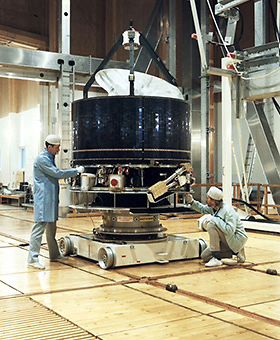Summary
- Space probe built by Airbus Defence and Space delivered first-ever close-up images of a comet’s nucleus 30 years ago
Thirty years ago, a tiny spacecraft called Giotto made history by flying within 600 kilometers of Halley’s comet. That trailblazing encounter by European Space Agency´s first deep space probe on 13/14 March, 1986 captured the public’s imagination. It became known as the ‘night of the comet’ and boosted future comet-exploring missions.
Stunning images sent back by Giotto showed a black, peanut-shaped nucleus 16 kilometers long with craters and fissures emitting dense plumes of gas and dust. The masses of data sent back revealed that four-fifths of the ejected matter consisted of water.
The most exciting results came when Giotto detected complex molecules locked in the ice on Halley, leading to speculation that these could be the building blocks of life on Earth. Flying through the gas and dust cloud, Giotto’s instruments registered thousands of impacts from dust particles that almost jeopardised the mission.
The spacecraft survived the expected dust impacts and it was decided to program another comet visit for Giotto, this time to study the Grigg-Skjellerup comet in July 1992.28 years later, Rosetta, another ESA mission developed by Airbus Defence and Space, made history again when it orbited a comet for the first time, and achieved a first-ever touch-down in November 2014 with the Philae lander on the surface of comet Churyumov-Gerasimenko (67P).
Press contacts:
Gregory Gavroy
+ 33 1 39 06 89 42
gregory.gavroy@airbus.com
Jeremy Close
+ 44 14 38 77 38 72
jeremy.close@airbus.com
Ralph Heinrich
+ 49 89 607 33971
ralph.heinrich@airbus.com
Mathias Pikelj
+ 49 75 45 89 123
mathias.pikelj@airbus.com
Francisco Lechón
+ 34 91 586 37 41
francisco.lechon@airbus.com
